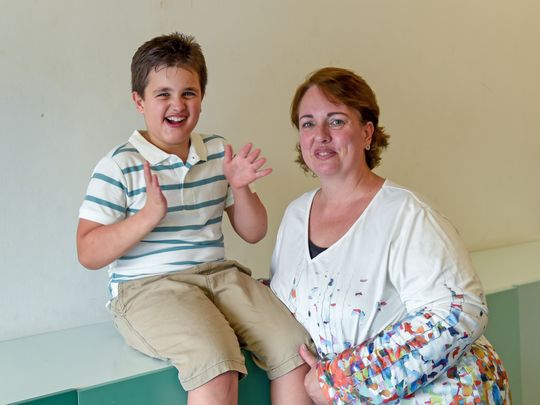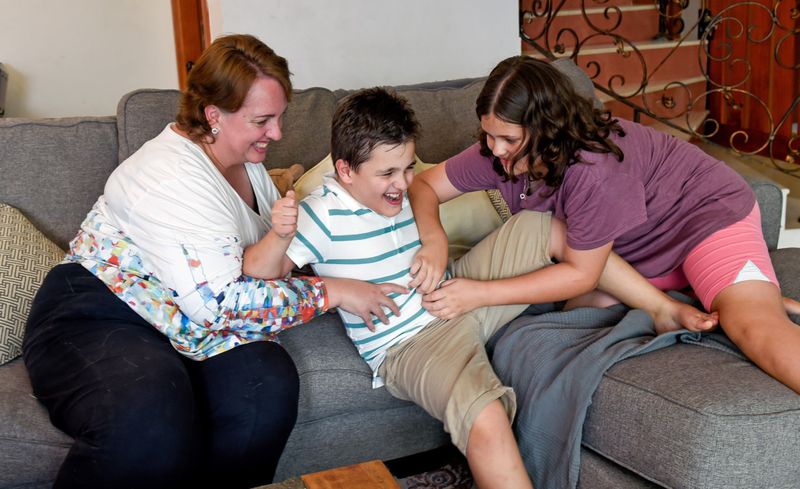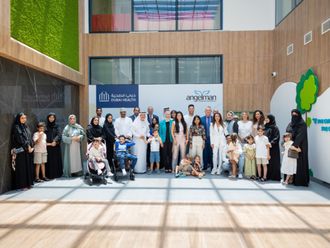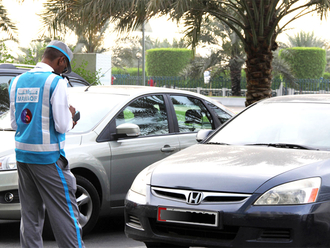
Dubai: A British expat living in Dubai has explained how she found out about her son’s rare genetic condition called the Angelman Syndrome.
Mother of two, Emily Ray said her second child – Sami – was not reaching his milestones as a baby.
“He was not rolling, crawling or walking. We took him to a specialist and the doctor took one look at him and said he has Angelman Syndrome,” she said, even as her elder daughter Maya-Sophia and son Sami look on. Sami with his bright cheerful smile and flapping hands, brings an instant smile to anyone meeting him for the first time.
What is Angelman Syndrome?
According to Dr. Khaldoun Osman, Consultant Neurosurgeon (Spinal Microsurgery) at Saudi German Hospital Dubai, “Angelman Syndrome is a rare genetic condition that affects the nervous system and causes severe physical and learning disabilities. A person with Angelman Syndrome will have a near-normal life expectancy, but they will need support throughout their life.”
Dr. Osman said: “Angelman Syndrome usually happens when the gene UBE3A is either missing or not functioning well. A gene is a single unit of genetic material (DNA) that acts as an instruction for the way an individual is made and develops. Usually, a child gets two copies of this gene, one from each parent, but only the gene from the mother is active. In most cases, Angelman Syndrome is caused by the child not getting a copy of the UBE3A gene from the mother, or the gene is not working. This means there’s no active copy of the gene in the child’s brain. In a small number of cases, Angelman Syndrome occurs when a child gets two inactive copies of the gene from their father, rather than one from each parent.”
Emily said her son Sami has Angelman Syndrome due to ‘Uniparental Disomy UPD’.
“This means he has two copies of the paternal chromosome 15 and no maternal chromosome. This means he is only missing a working copy of gene UBE3A. Individuals who have Angelman Syndrome due to deletion of the gene from the maternal chromosome also have other genetic material deleted above and below the gene. So they tend to be more severely affected, e.g. with seizures, mobility/feeding issues. In Sami’s case, no other genetic material is missing so he has no other medical issues. He can run, jump, walk, climb, feed himself, has no troubles swallowing and his sleep has improved with age,” explained Emily.
Making a difference
Emily said Sami’s genetic disorder in effect attracts many to come and talk to him and get to know him. “His bright smile brings an instant smile to people’s faces.”

She recounted one such special relationship. “Maya, Sami and I would go to a nearby supermarket. The security guard there took to Sami instantly. The two bonded and became close. One day the guard informed me he had lost his job. I felt very sad. Because we could not imagine not seeing him at the supermarket. With a huge smile and a twinkle in his eye, he would give Sami high fives. Sami adored him,” she said.
“I found out he was a qualified primary teacher in Uganda, with a B.Ed degree. He coached football and cricket as well. I casually reached out to community groups for any job availability for him. And we found a loving Swiss family who decided to hire him to take care of their two autistic children,” she added.
The guard Mohammed is grateful. He told Gulf News: “I got the job only because of Sami.. I have been blessed to find a great family and two beautiful children who I live with. I am so grateful.”
Emily said coping with an Angelman Syndromw child had taught her many things. “Parents with children of special needs must accept the situation first. The next is to deal with the child’s condition and give your child the maximum love and support. If your child is diagnosed with this rare condition, you can talk to a doctor about what support they can provide. There is currently no cure for Angelman Syndrome.”
According to Dr. Osman, several distinctive behaviours are associated with Angelman Syndrome, although a child with the condition may not have all of these behaviours. “Some of them include frequent laughter and smiling, often with little stimulus, being easily excitable, often flapping the hands, being restless (hyperactive), having a short attention span,” said Dr. Osman.
Causes of Angelman Syndrome
Dr. Osman said: “Most children with Angelman Syndrome are diagnosed between the ages of nine months to six years, when physical and behavioural symptoms become apparent. In most cases of Angelman Syndrome, the child’s parents do not have the condition and the genetic difference responsible for the syndrome happens by chance around the time of conception.”
He said that a child with the genetic condition will begin to show signs of delayed development at around six to 12 months of age, such as being unable to sit unsupported or make babbling noises. “Later, they may not speak at all or may only be able to say a few words. However, most children with Angelman Syndrome will be able to communicate using gestures, signs or other systems,” explained Dr. Osman.
Diagnosing Angelman Syndrome
Dr. Osman said that Angelman Syndrome may be suspected if a child’s development is delayed. “A blood test is used to confirm the diagnosis. Several genetic tests will be done on the blood sample. These tests look for any chromosomes or pieces of chromosomes that are missing. They look for any changes in the mother’s or father’s UBE3A gene. They also look for changes in the child’s UBE3A gene that would stop it from working.”
He said: “For each child with Angelman Syndrome, it is important to know the genetic change that caused the condition. This helps to determine your chance of having another child with Angelman Syndrome.”










